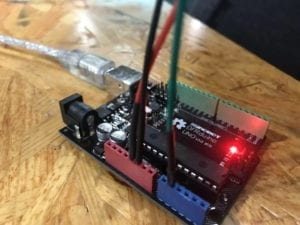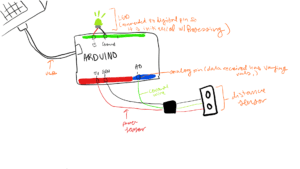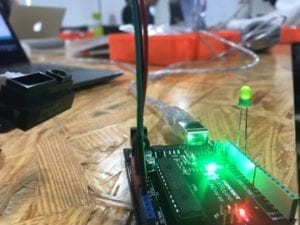Our Circuit
For this recitation, my partner and I chose to work with a distance sensor, as the schematics were relatively simple. First, we connected the sensor to the Arduino (as an analog input).

Once we had it connected, we chose to create a sketch which utilized Serial.println() to log the distance value as given by the sensor. To create this sketch, we referred to the following example code, this link also helped us to set up our sensor (link).

Then, once the values logged were fairly accurate, we went on to connect an LED as a digital output, and used if statements to make the LED turn on only when something got to a certain distance from the sensor.



The schematics for this were fairly simple as we chose not to use a breadboard, and therefore, everything was connected to an Arduino. However, I would like to experiment more with this concept and more LEDs in the future.
Question 1
While assembling our circuit, we didn’t have a set idea of a thing which we wanted to assemble. Rather, we chose to play with the components until we got something to work. However, in the end, I feel that our circuit works similar to a porch light, a light in front of a door of a house which turns on when somebody walks close to it. Therefore, it could be used by many people, and though the concept is simple, it is relatively useful. I also feel that the concept we used could also work like a doorbell, or like the music that plays at family mart, as the schematics would be similar.
Question 2
I think people often use this metaphor for coding as it is basically a “recipe” for a computer to follow. However, I find that this metaphor doesn’t fully cover the complexities within coding as computers require very specific instructions to complete a task. Along with this, I feel that this makes coding seem boring. Often, code can be playful as well. Personally, I feel that coding is more a way of problem solving, as you have your problem (desired solution) and you have to find a path to get there. Therefore, it’s less of a tutorial and more of a way to use creativity and logic to get a result. Also, you may find a new result or solution as a side effect of your code that does something even better than you intended.
Question 3
I feel that the computer has a large impact on our behavior. For example, we have become reliant on computers for many aspects of our life. Along with this, I feel that many of the things we create artistically has evolved to have a basis on the computer. Whether it’s drawing digitally, working with a 3D game engine, or writing creative code, our ways of creating have been modified to be based on modules and snippets of code. Along with this, we are also reliant on forms of social media to keep us in touch with friends and family. When we talk with friends online, the syntax we use is different in daily life. As we cannot easily convey emotion in short texts, we use abbreviations, capitalize letters, or send emojis, things which we would not do in a normal vocal conversation.